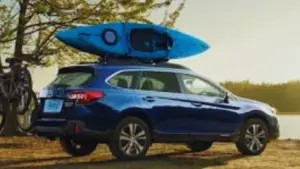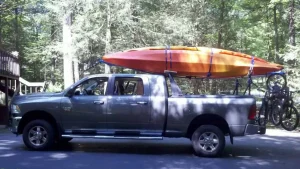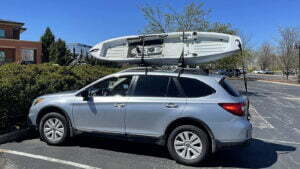Are you planning your next kayaking trip? Don’t forget about reliable kayak racks! Our 2023 guide to the best kayak racks will help you transport your kayak safely and securely.
Kayaking is a popular outdoor activity that offers an excellent way to explore waterways and enjoy the beauty of nature. However, one of the biggest challenges of kayaking is transporting your kayak to your preferred location. A good quality kayak rack is an essential accessory that can make the transportation of your kayak easier and more secure.
If you’re in the market for a new kayak rack, you’ll be pleased to know that there are plenty of options available on the market. To help you make the best decision for your needs, we have put together the ultimate guide to the top 16 best kayak racks of 2023. Our expert reviews and detailed analysis will provide you with all the information you need to make an informed decision on which kayak rack is right for you.
Table of Contents
ToggleBest Kayak Racks: Specs & Features
Malone SeaWing
Our ratings
- Material: Nylon
- Type: Saddle
- Capacity: 70 pounds
- Straps: Included
- Crossbars: Not included
Thule 898 Pro Hullavator
Our ratings
- Material: Double-coal steel
- Type: Saddle
- Capacity: 36 inches, 75 pounds
- Straps: Included, 2 x 9.5 feet
- Crossbars: Not included
TMS J-Bar
Our ratings
- Material: Steel
- Type: J-Cradle
- Capacity: 36 inches, 75 pounds
- Straps: Included
- Crossbars: Not included
ECOTRIC J-Bar
Our ratings
- Material: Steel, Rubber
- Type: J-Cradle
- Capacity: 36 inches, 165 pounds
- Straps: Included
- Crossbars: Not included
YAKIMA Rooftop Mounted
Our ratings
- Type: J-Cradle
- Capacity: 80/110 pounds
- Dimensions: 20.2 x 10.4 x 7.8 inches
- Straps: Included
- Crossbars: Not included
HandiRack
Our ratings
- Type: Temporary Pads
- Capacity: 175 pounds
- Straps: Included
- Dimensions: 14.6 x 7.4 x 5.7 inches
- HandiPump: Included
Malone Downloader J-Style
Our ratings
- Type: J-Cradle
- Capacity: 75 pounds
- Dimensions: 21 x 10 x 8 inches
- Straps: Included, cam-style with buckle protectors
- Crossbars: Not Included
Thule Dockglide
Our ratings
- Type: Saddle
- Capacity: 36 inches, 85 pounds
- Dimensions: 15.8 x 8.5 x 8 inches
- Straps: Included, with rubber buckle protectors
- Crossbars: Not Included
ABN Kayak
Our ratings
- Type: J-Cradle
- Capacity: 36 inches, 75 pounds
- Dimensions: 21.25 x 19.5 x 8 inches
- Straps: Included, made from Nylon
- Crossbars: Not Included
Rhino Rack Nautic 570
Our ratings
- Type: Saddle
- Capacity: 75 pounds
- Dimensions: 10 x 7 x 6 inches
- Straps: Included, with unique buckle protector
- Crossbars: Not Included
Thule Hull-A-Port Rooftop Rack
Our ratings
- Type: J-Cradle
- Capacity: 34 inches, 75 pounds
- Dimensions: 20 x 10.5 x 5.5 inches
- Straps: Included
- Crossbars: Not Included
Best Kayak Racks Review: Top Kayak Carriers
1. Malone SeaWing: Best Overall
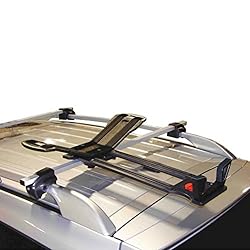
Malone’s use of cutting-edge technology in the construction of the unusual V-saddle rack sets it apart from the competition.
With the SeaWing saddle, you can transport two kayaks instead of one, and still save room. This is helpful for groups of people who don’t want to leave anyone out of the water fun.
Any shapes of oval, round, and square cross rails can be used with the Jawz mounting hardware. You may safely transport your gear with the help of the buckle protectors and load straps. Use the stern tie-downs and the safety bow for maximum security.
Amazingly for a tool of its size, this kayak rack can support loads seven times its own weight. The abrasion-resistant Nylon construction ensures that this roof extension for your car will last for years. If you fasten it to your car’s roof, you’ll have easy access to a large amount of extra storage space for your belongings.
What we like
- The saddle design allows attaching water gear straightforward.
- Loading and unloading your kayak requires no additional equipment.
What we don't like
- Large kayaks cannot use the flexible wings.
2. Thule 898 Pro Hullavator: Best Lift Assist
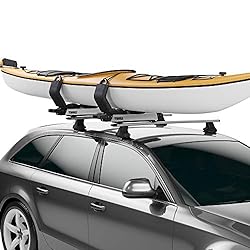
If you’re going to be kayaking on your own, the Thule lift system will come in quite handy. Although the Hullavator’s initial cost may seem high, it quickly pays for itself when you consider how much time and effort you will save by not needing another person to help you load and unload your luggage.
This rack is so flexible that you can even use it to transport your kayak by securing it to the side of your car instead of just the top. With the gas-assisted struts, you can securely lift and load your kayak into the car, where it can be secured with utmost care.
Cradles may be extended to a maximum width of 36 inches to accommodate vessels with broader hulls. They have eight cushioned touch spots to further safeguard your electronics.
Double-coal steel is used in the construction of the hardware, and an aluminum coating protects it against rust
What we like
- Waist-level loading lets you load and unload items alone.
- Eight cushioned touch locations prevent boat damage.
What we don't like
- Only Thule crossbars work.
- Holds one kayak.
3. TMS J-Bar: Best for Budget
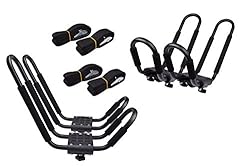
The TMS J-Bar kayak rack is proof that an affordable price tag does not necessarily imply a subpar product. It’s intended use is as a carrier for watercraft such as kayaks, canoes, bicycles, and surfboards, and it’s designed to work with a wide variety of crossbar configurations.
Its steel frame and customizable cushioning mean you can mount your kayaks securely without straining to load or unload.
It has lots of storage space, and you can even tie your kayak to the side of it to save some weight. Use the rack’s straps to keep your belongings secure on the roof. This rack is suitable for most kayaks due to its large capacity (up to 36 inches in width and 75 pounds in weight).
The manufacturer has included two rack sets and provided a lifetime guarantee to make the package as attractive as possible.
What we like
- Racks fit most crossbars.
- The broad opening makes gear loading and unloading fast.
What we don't like
- Simplicity works.
4. ECOTRIC J-Bar: Best for Loading and Unloading
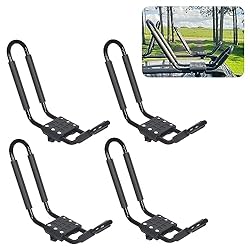
If you’re going to be kayaking on your own, the Thule lift system will come in quite handy. Although the Hullavator’s initial cost may seem high, it quickly pays for itself when you consider how much time and effort you will save by not needing another person to help you load and unload your luggage.
The rack’s sturdy steel frame is outfitted with flexible cushioning for optimal equipment placement.
This rack may be installed into the crossbars of any brand. The crossbars can have practically any shape, including flat, oval, square, or circular. You won’t need to buy anything else because all of the straps and mounting hardware are already in the package.
Put as much gear as you like on your rack (up to 165 pounds! ), then paddle off on your kayaking excursion without worrying that anything will fall off.
What we like
- 2 sets of 4-kayak racks are included.
- Hardware and straps are supplied.
What we don't like
- Assembly is difficult.
5. YAKIMA Rooftop Mounted: Most Versatile
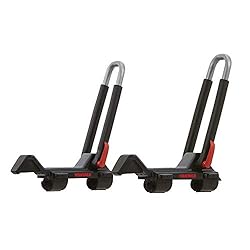
Maybe YAKIMA’s newly designed kayak rack is the most low-maintenance option available. The ability to stow stuff on its side means you can bring along an extra kayak (amounting to 110 pounds of weight capacity for both). Instead, you may transfer your gear in the J-cradle configuration, which can hold one kayak weighing up to 80 pounds.
The cushioned contact areas offer the necessary grip and stability for the sometimes uneven wilderness routes. There is no need to go out and buy any extra hardware because it is all included, even down to the straps.
In addition, the roof rack won’t take you more than 10 minutes to set up because its assembly is as simple as counting to three.
The kayak cradles may be folded flat and left on the rack whenever they are not in use. In this way, you won’t have to waste time taking the rack off the car and putting it away in the garage every time you’re not using it.
What we like
- Kayaks are popular because of their portability.
- Padded contact points keep kayaks stable during transport.
What we don't like
- The rack makes noise when stowed.
6. HandiRack: Best for Low Maintenance
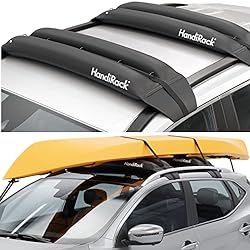
The HandiRack inflatable kayak rack is superior to other competitors because of its low maintenance requirements. From compact cars and crossover SUVs to full-size pickup trucks and even 5-door hatchbacks, it works with them all.
The tool’s inflatable mechanism allows it to be deflated and stored in a compact bag when it’s not in use. The rack’s built-in cam buckles are exceptionally sturdy, making the possibility of losing any gear quite remote. The D-Rings add further security to the rack’s included straps.
The user manual is straightforward, and you won’t need any other equipment to set up the rack. It is possible to save money on moving your water equipment by using roof bars instead of purchasing costly side rails or gutters.
Whatever you need to move, from canoes and skis to sofas and hutches, you can trust this rack to get the job done securely.
What we like
- It works on bare roofs, elevated and sturdy roof rails, and all vehicles.
- Rack installation takes 5 minutes.
What we don't like
- Deflates quickly.
7. Malone Downloader J-Style: Most Affordable
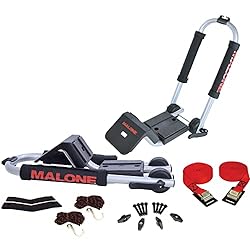
The Malone Downloader J-style kayak rack is the cutting-edge device you didn’t know you needed, thanks to its aluminum structure and universal mounting gear.
The rack’s fold-down function, which is meant to preserve the quality of the toll, makes it equally as effective as, if not more so than, conventional cradle-type racks in terms of conserving space.
Carrying up to 75 pounds is simple and won’t do any harm to your car’s roof or inside. The rack’s ‘loading ramp’ is useful for pushing the large vessel when other people aren’t there to help.
The rack’s included hex bolts mean it’s suitable for use with any style of crossbar. You may safely move your belongings without worrying about damaging them, no matter what form your crossbars are.
What we like
- Folding down increases overhead clearance.
- Rack padding protects items during transportation.
What we don't like
- Low weight capacity.
8. Thule Dockglide
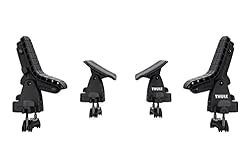
The Thule Dockglide kayak saddle rack is ideal if you’re a water sports fanatic who needs to bring a variety of gear with you on a daily basis.
The saddles in this design may be pivoted individually to any angle. Changing them to fit the size and form of the gear is easy and doesn’t impair security.
Also, the equipment and the vehicle are protected from damage by the big and adaptable cushioned cushions. With the horizontal position, you may transport items up to 36 inches wide and 85 pounds in weight.
Rubberized buckles on the middle load straps keep your boat in place. The paint on the water gear, which generally shows wear and tear first, won’t be harmed.
What we like
- Has T-rack attachments for most Thule crossbars.
- Stand-up paddleboards can be used with the angle-setting system.
What we don't like
- Compatible exclusively with Thule racks.
9. ABN Kayak
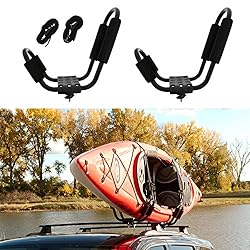
Auto Body Now (ABN) has introduced a reasonably priced water gear tool that can be used to transport your vessel from point A to point B. Because of its distinct edge, it stands out among other players in the water tool industry.
Constructed from high-quality steel with an additional rust-resistant coating, it will help keep your car safe from scratches and other damage. Padding at the large opening of the frame facilitates loading and unloading and protects your vessel from dings.
Water equipment may be transported on its side, allowing for as many as four racks to be piled on the car’s top. This rack is compatible with round bars and cargo rails.
Assembling the rack onto the crossbars will take a little bit of your time and effort (you’ll need a tool to tighten the screws), but not too much. With no prior tool skill required, anybody may successfully mount the rack.
What we like
- Its rack's steel construction makes it durable.
- Cheap.
What we don't like
- Rack straps are poor.
10. Rhino Rack Nautic 570
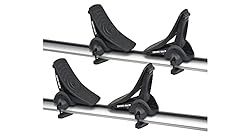
The Rhino Nautic 570 is a common saddle rack with its four rubber cradles and three grip-infused joints for safely mounting watercraft. Like the two claws that keep the gear in place from underneath, this mechanism is ingenious.
To load your kayak from the side, just move one claw to the side of the vehicle, place your stuff on it, and then roll the kayak back into the transport position; the pads can swivel a full 180 degrees. This system allows you to load equipment onto the roof of the car without the necessity of a ladder or any help from outside the vehicle.
The cradles’ pads can fit boats with a wide variety of hull shapes, although it may take some trial and error to discover the optimal mounting location for your vessel.
This multipurpose saddle rack comes with a 5-year warranty, so you know you’ll get your money’s worth for years to come.
What we like
- 180-degree rotation permits loading from either side.
- Its UV-protection and waterproof construction appeal to kayakers.
What we don't like
- Round crossbars incompatible.
11. RaxGo Folding
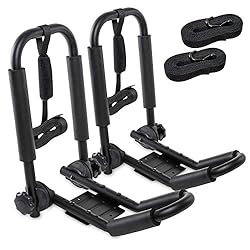
RaxGo’s marketing slogan of “rack up your water experiences” was developed to appeal to kayakers and other water sports fans. What’s more, it was successful. Many kayakers and surfers rely on the premium folding kayak for hauling gear weighing up to 165 pounds.
The racks, of which there are two in the set, are crafted from sturdy steel to keep them from rusting and to increase their lifespan. The T-slider bars and the crossbars both function, so they may be used with a wide variety of vehicle roof configurations.
All the tools and knowledge you’ll need to put up the racks are supplied in the package in the form of diagrams in the instructions, so you can get started right away. Straps are unnecessary due to the 4-point safety system. Place the rack or racks on top of your automobile and be ready for a journey full of water.
What we like
- Polyester safety straps are durable and high-quality.
- Heavy boats may be transported with a 165-pound capacity.
What we don't like
- Compatible with 2-2.5-inch crossbars only .
12. AA-Racks J-Bar
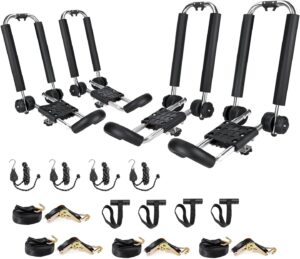 The J-Bar kayak roof rack from AA-Racks is made of epoxy powder-coated steel and may quickly become a trusted traveling companion.
The J-Bar kayak roof rack from AA-Racks is made of epoxy powder-coated steel and may quickly become a trusted traveling companion.
In a matter of minutes, it can be stacked on the top of your car and filled with your water gear, making the trip back to base much less stressful. You may safely load more than 100 pounds of equipment onto the roof, and it will not shift as you drive.
The rubberized bottom and foam padding protect your vehicle’s interior from dings, and the reinforced cargo strap patches ensure that your belongings will stay put during the trip. Once you’ve strapped down your gear and fastened the carrier to the rails of your roof rack, you’re ready to take on the waves, rivers, or any other body of water you choose.
When you get home after your vacation, just fold down your rack and leave it on your car so you can park it in the garage. Really, it’s that simple.
What we like
- The rubber pedal and foam protector are UV- and water-resistant.
- Cheap.
What we don't like
- When buying this item, discover crossbars that fit the rack.
13. Rola J-Style
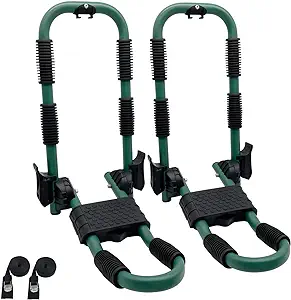
The Rola J-Style rack is the best option if you only need to carry one kayak on your roof. Powder-coated steel prevents damage from abrasion and rust, making this tool suitable for use with damp equipment.
There’s no need to worry about your kayak falling out in the middle of the road because of the built-in straps that hold it in place. You won’t need any extra help from anybody else to carry your water machinery onto the rack.
The kayak will need to be lifted, hooked into the rack, and strapped down. No matter what the day’s weather does to your kayaking plans, the foam pads and high-quality stern tie-downs will keep your boat safe.
The name recognition and superior craftsmanship of a higher-priced brand mean that you can expect your investment to yield returns sooner rather than later.
What we like
- Quality equipment lasts a long time.
- Universal hardware works with ROLA and most crossbars.
What we don't like
- Costly.
14. Vault Cargo
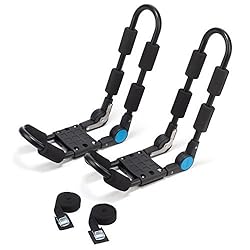
You may have noticed that J-Cradle roof racks feature often throughout this book.
Their affordability, adaptability, and dependability are proving invaluable. The kayak roof rack that Vault Cargo offers is exactly that, and it includes all the deluxe and standard features of a high-end product.
The sturdy metal frame is complemented with bars that are cushioned with plush padding for added safety. By coating it in high-quality material, the maker greatly reduced the possibility of corrosion.
As the racks collapse when not in use, you may leave them mounted on your car’s roof all year round. You won’t have to go out and buy anything more because two adjustable lashing straps are included in the package.
If your vehicle doesn’t come with crossbars, you may save 10% by purchasing the Universal Roof Rack crossbars model from Vault Cargo.
What we like
- Packaging includes mounting hardware.
- When not in use, the 180-degree folding motion rack folds down.
What we don't like
- Poor load straps.
15. Thule Hull-A-Port Rooftop Rack
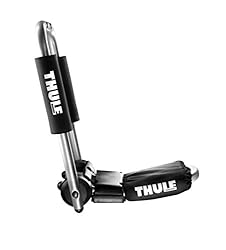
Thule’s Hull-A-Port rooftop rack is an excellent example of its “beefy” reputation. You’d be hard pressed to tell if this heavy thing is meant to help move kayaks or if it’s a piece of exercise equipment. This rugged appearance is indicative of the high quality of the rack within.
Its steel frame and customizable cushioning offer carrying strength and safety that few roof racks can match. The two cradles of this type may be fastened to virtually any roof rack and round crossbars in a matter of minutes without the need for any tools.
Hooks and ratchet straps can be used in addition to the two straps that come with the rack to connect the kayak’s ends to the roof. There are compartments for stowing the ends of the straps, and a PFD (pull, fold, down) lever allows you to fold it up quickly.
There is currently no locking mechanism in place, but one can be purchased from Thule Cargo or a wire may be wrapped around the apparatus to secure it. If everything is ready, you may launch into your transcontinental kayak adventure.
What we like
- Loading and unloading the boat doesn't require assistance.
- Rust-resistant coating extends tool life.
What we don't like
- The rack bolts are too short for secure installation.
16. Great Lakes Wing-Sea Kayak Rack
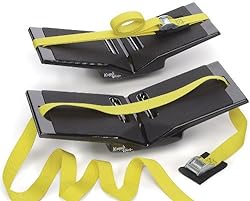
The Sea-Wing from Great Lakes is a good example of a compact roof rack that can hold all of your watersports equipment without taking up too much room in your vehicle.
The width of your sea kayak must be less than 30 inches for this style of roof rack to work.
The greatest part is that the rack comes with everything you need to set it up, so you won’t even have to get out your toolbox. This allows you to spend less time assembling and more time actually paddling.
Roof racks are notorious for scratching and denting vehicles, but this rack is made specifically to avoid those problems. Roof racks of this style work well on boats with a keel or a V-shaped hull.
This Wing-Sea kayak rack is adaptable to most roof rack crossbar systems.
What we like
- Pre-assembled roof racks are easier to attach on crossbars.
- 5-year guarantee from the manufacturer
What we don't like
- Not appropriate for over-30-inch kayaks.
What to Consider When Buying a Kayak Roof Rack
1. Weight limit
The manufacturer of your kayak carrier or roof rack will provide you with instructions, which will include the maximum weight the device can hold. If the carrier can carry more than one kayak, the capacity may be specified as either a per-kayak limit or a total limit; check to see which applies and don’t overload the carrier. Certain kayaks, such sit-on-tops and fishing kayaks, might be too heavy for standard carriers. You should search for one like Yakima’s BigCatch that is made to carry a lot of weight.
2. Type
There are four distinct kinds of kayak trailers. The first type of kayak rack is the saddle rack, which holds your kayak flat on the ground. A single kayak may be safely and conveniently transported in this fashion. The next option is the J-cradle, which employs J-shaped bars to carry your kayak at a 45-degree inclination. If you have a narrow rooftop and wish to carry two kayaks, this is a great solution. If you don’t have crossbars, you’ll need a stacker to transport numerous kayaks (often as many as four) vertically, while temporary foam or inflatable pads are your only other alternative.
3. Price
Kayak roof rack prices range from little under $100 to close to $900. The more expensive ones are built with superior materials that won’t corrode after repeated exposure to salt water, have a lifetime warranty, and have hydraulic load assist for simple loading and unloading at waist level (ideal for single kayakers). Your budget, needs, and expected use will all play a role in determining the optimal spending range for your carrier.
4. Size
The dimensions (height, breadth, and total roof area taken up) of kayak carriers can vary widely from one design to the next. If you want to install a second carrier or other roof accessories beside it, you need make sure the measurements are consistent with the size of your rooftop. When it comes to carriers, height isn’t usually a concern as long as you choose with the ones that fold down when not in use (first prize) or can be readily removed for transport and storage.
5. Car compatibility
The question “does it require crossbars?” is the starting point for evaluating the suitability of potential kayak carriers. If your car doesn’t have them already, you may either permanently attach them or use temporary pads made for cars with exposed roofs. If you already own crossbars, you should ensure that your prospective buy is appropriate for both the breadth and the form of your crossbar spread. The vast majority of kayak carriers are made to fit any crossbar size, and if yours isn’t, an adapter kit is likely to be sold separately.
Best Kayak Racks FAQs
Q. What are the different kinds of kayak racks?
J-cradles, saddles, stackers, and temporary pads are the four most common forms of kayak racks. Know which one applies to your kayak and your mode of transportation.
Because of its adaptable design, the J-Cradles is among the most popular kayak racks available. The rack’s side loading design frees up valuable roof real estate for additional uses. With the correct gear, transporting and stowing your kayak is a breeze. Nevertheless, a roof rack of this kind is not the best choice for a vehicle with a narrow roof.
Those who just need to carry one kayak should opt for the saddle roof rack. Depending on the breadth of your car’s roof, you may use either a single cradle or two cradles that are attached to one another. Due to the huge storage area it provides for your water gear, this sort of roof rack is ideal for use in extreme weather.
The Stacker roof rack is a great option for transporting many kayaks at once. This kayak stand is unique in that it allows you to store your kayaks upright and on their sides, rather than horizontally as you would with regular kayak stands. Because of this, you can store many kayaks when before you could only store one. You may rest easy knowing that your gear won’t fall off during transit if you take the time to properly attach it.
Installing and removing temporary pads is the simplest method for kayak racks. Straps on the interior and exterior of your car’s roof can keep your belongings from flying about. These basic racks with integrated foam or inflated cushioning are the best option for short journeys.
Q. What things should I think about before I buy a kayak rack?
It’s the truth, though, that there are a few things to consider when you buy a kayak roof rack. The number of kayaks that can be carried, the type of vehicle that can do so, the rack’s material, and the rack’s cross bar system are all relevant factors.
Outdoor enthusiasts still make the error of cramming too many kayaks onto relatively tiny racks, despite the fact that the more the number of kayaks you want to transport, the larger the dimensions of the kayak rack should be. A good rule of thumb is to never put your kayaks at danger by piling up your car’s top in the hopes that you can secure them all. It’s preferable to be cautious than sorry on the road, as accidents occur more frequently than you would imagine.
It is possible to transport one or two kayaks in a small automobile, and even more in a larger vehicle. You should measure your car’s roof to determine which roof rack will be the most stable for carrying many kayaks.
It’s as crucial to have the correct sized tool as it is to get good quality material for the kayak rack. Kayakers should never use aluminum or plastic fasteners, as these materials are prone to come loose under stress. For the sake of safety on the road, it is best to spring for the more expensive type constructed of steel and covered with a rust-proof coating.
The rack attachment requires a cross bar system, which is not standard equipment on all vehicles. If your car doesn’t have a built-in cross bar system, you’ll need to buy one before you can use a roof rack. Make sure the height of your rack is proportional to the height of your roof so that loading and unloading the water equipment is a breeze.
Q. How many kayaks can a roof rack hold?
It is possible to securely transport two kayaks on a standard roof rack. These capacities are the most widely available and most preferred on today’s market. But, there are roof racks that may accommodate as many as four kayaks, especially if they are stowed laterally and vertically.
Although it has been suggested that three kayaks may fit on the standard two-kayak roof racks, we advise against it. Buying extra fasteners to secure more kayaks might seem like a good idea at first, but there’s no assurance that you won’t accidentally harm your water gear on the way.
Q. How do I tie my kayak to the rack on the roof?
Tie-down instructions for your kayak’s roof rack are included in the box nine times out of ten. To safely fasten your gear to the kayak, they mark the anchor points so you can use a loop of cord to wrap around the kayak. It’s important to secure your kayak so it won’t fall off while you’re paddling, but not so tightly that it damages your vessel.
To secure the kayak by its bow and stern, first attach the bow line to the tow’s hooks. A hitch may be useful for securing the stern line and finding the optimal center of gravity while carrying your boat on the roof. It’s important to remember to tie any dangling ends in a couple of knots so they don’t get snagged while you’re transporting your boat.
Q. What is the best way to carry my kayak onto the roof rack?
In spite of your first fears, loading your kayak onto the roof rack all by yourself is quite achievable with the help of the manufacturer’s loading instructions. The most common sliding bar is helpful for loading the kayak since it distributes the load across many body limbs. When you have loaded all of your stuff and the kayak is safely attached to the roof, you may replace this bar.
If the rack doesn’t include a lift assist system, you’ll have to move the heavy equipment without any help. When placing the kayak on the roof, ensure it is dry and clear of any other items. If you want to protect your car’s roof from being scratched while you load, you may do it using a sheet. Once you’ve loaded your kayak onto the roof, make sure to secure it according to the manufacturer’s guidelines.
Best Kayak Racks Final Thoughts
There is a lot riding on a kayaker’s ability to locate a suitable kayak rack. It protects your car and your kayak while in transit and makes going on kayaking adventures more pleasant. To help you find the finest kayak rack for your needs, we have compiled a list of the top 10 models currently available in 2023. We’ve done the hard work for you, researching and comparing the top alternatives on the market and laying out all the details for you.
Choosing a kayak rack requires thinking about the number of kayaks you need to move, the size of your vehicles, and the boats themselves. If you’re going to be storing heavy items on the rack, pick one that will last and is simple to set up and load.
We recommend the Malone SeaWing kayak rack since it is one of the most flexible options available.
It may carry a canoe or various rigid or inflatable paddle boards in addition to one or two kayaks.
If you spend the money on a high-quality kayak rack, you won’t have to worry about the safety of your kayak during transit, and you can concentrate on having a great time on your kayaking trip. We hope you’ve found this advice useful in your search for the ideal kayak rack. Kayaking, have fun!
Related articles:

